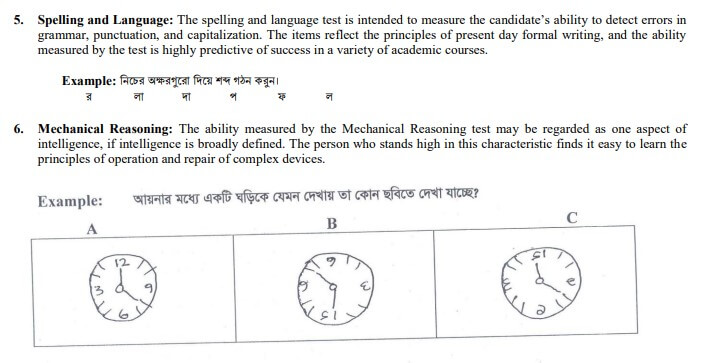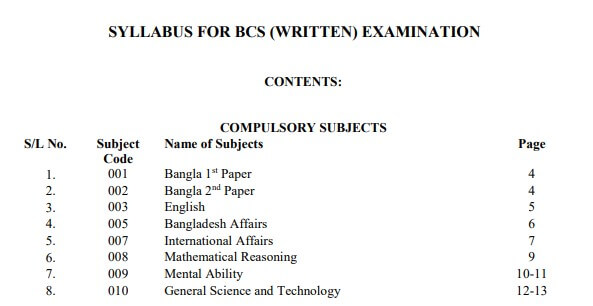Here’s the BCS written syllabus with a PDF download file. Download the original BCS syllabus for the BCS examination from bpsc.gov.bd. Let’s see all the details of the BCS written syllabus. The Bangladesh Public Service Commission provides this BCS syllabus.
SYLLABUS FOR BCS (WRITTEN) EXAMINATION
| S/L No. | Subject Code | Name of Subjects |
| 1. | 001 | Bangla 1st Paper |
| 2. | 002 | Bangla 2nd Paper |
| 3. | 003 | English |
| 4. | 005 | Bangladesh Affairs |
| 5. | 007 | International Affairs |
| 6. | 008 | Mathematical Reasoning |
| 7. | 009 | Mental Ability |
| 8. | 010 | General Science and Technology |
Bangla 1st Paper

Bangla 2nd Paper

English

Bangladesh Affairs


International Affairs



Mathematical Reasoning

Mental Ability



General Science and Technology
Subject Code: 010
Part – A: General Science Marks – 60
Light: Nature, Spectrum, Different colors and wavelengths, UV, IR, and LASER, Reflection of Light, Refraction of Light, Total Internal Reflection of Light, Lenses, Thin converging lens, Dispersion of light, particle nature of light, Einstein’s photoelectric equation, photocells.
Sound: Hearing mechanism, Decibel, Frequency, Sound machines in the home and around, Microphone, Loudspeaker, Public address system, Characteristics of a sound note, Formation of stationary waves in stretched string, Laws of vibrating strings, Beats, Doppler Effect, Applications and limitations of Doppler Effect, Echoes, Absorption of sound wave, Reverberations, Fundamentals of Building acoustics, Statement of Sabine’s formula
Magnetism: Polarity and relationship with current, Bar magnet, Magnetic lines of force, Torque on a bar magnet in a magnetic field, Earth’s magnetic field as a bar magnet, Tangent galvanometer, Vibration magnetometer, Para, dia and ferromagnetic substances with examples, Electromagnets, and permanent magnets.
Acid, Base, and Salt: Acid-base concepts; characteristics of acids and bases; acid-base indicators; use of acids and bases in daily life and caution in handling them; social effects of misuse of acids; reason for acidity in stomach and selection of the right food; pH; measurement and importance of pH of substances; salts; characteristics of salts; the necessity of salt in daily life; uses of salts in agriculture and industries.
Water: Properties of water; melting and boiling points of water; electrical conductivity; structure of water; hydrogen bonding; sources of water; sources of fresh water in Bangladesh; water quality parameters (color and taste; turbidity; the presence of radioactive substances; the presence of waste; dissolved oxygen; temperature; pH and salinity); recycling of water, the role of water in the conservation of nature; the necessity of quality water, purification of water (filtration; chlorination; boiling and distillation); reasons for pollution of water sources in Bangladesh; effects of water pollution on plants, animals and human beings; effects of global warming on freshwater; strategy for preventing water pollution and responsibility of citizens or public awareness; prevention of water pollution by industries; prevention of water pollution due to soil erosion from agricultural land; conservation of water sources and development.

Our resources: Soil; soil types; soil pH; reasons and effects of soil pollution; natural gas and its main compositions: processing, uses, and sources of natural gas, petroleum, and coal; forestry; limitations and conservation of our resources.
Polymer: Natural and synthetic polymer; polymerization process; sources, characteristics, and usage of natural and synthetic polymers; manufacturing process, characteristics, and uses of fibers, silk, wool, nylon, and rayon; physical and chemical properties of rubber and plastic; the role of rubber and plastic for environmental imbalance; aware of using rubber and plastic.
Atmosphere: Biosphere and Hydrosphere, Ionosphere, role of oxygen, carbon dioxide, and nitrogen. Potable and polluted water, Pasteurization.
Food and Nutrition: Elements of food; carbohydrates; protein; fats and lipids; vitamins; types and sources of carbohydrates, proteins; nutritional value; menu of a balanced diet; the pyramid of a balanced diet; body mass index (BMI); fast food or junk food; preservation of food; various processes of storing food; use of chemicals for preservation of foods and its physiological effects.
Biotechnology: Chromosome; shape, structure and chemical composition of chromosome; nucleic acid; deoxyribonucleic acid (DNA); ribonucleic acid (RNA); protein; gene; DNA test; forensic test; genetic disorder in human beings; Biotechnology and Genetic Engineering; cloning; social effects of cloning; transgenic plants and animals; Use of biotechnology in agricultural, milk products and pharmaceutics; Gene therapy: Genetically modified organism; Nanotechnology: Pharmacology: Pharmacokinetics
Disease and Healthcare: Deficiency, Infection, Antiseptic, Antibiotics, Stroke, Heart Attack, Blood Pressure, Hypertension and Diabetes, Dengue; Diarrhoea; Drug addiction, Vaccination, Cataract, food poisoning, X-ray; Ultrasonography; CT Scan; MRI; ECG; Endoscopy; Radiotherapy; Chemotherapy; Angiography; uses, risk and side-effects of above techniques; Basic concept of Cancer, AIDS and Hepatitis


Part – B: Computer and Information Technology
Computer Technology: Organization of modern personal computer and its major functional units, computer generations, History of computers, central processing unit and microprocessor, computer memories and their classification and characteristics, input and output devices with characteristics and uses. The role of BIOS. Bus architecture, Motherboard and its components, functions, and organization of microprocessors, Arithmetic Logic Unit(ALU), Control unit, Language translator, Text editor, Compiler, Interpreter, Computer software, system software, operating system, application software with examples of applications, Computer virus, office automation. Computational biology; Role of computer in Drug design; Programming languages, their types and levels, steps for software development. Impacts of computers on society.
Information Technology: Data communication and information, information collection, processing, and distribution, System analysis, and information systems, expert systems. Database software and structures, Database Management System (DBMS), Basics of multimedia systems with examples of hardware and software, concept of data compression, multimedia system development life cycle. Local area, metropolitan area, and wide area computer networks, (LAN, MAN, WAN), LAN Topology, Networking devices(Router, Switch, HUB), TCP/IP Protocol suite, Internet, Internet services and protocols, Internet Service Providers(ISPs) and their responsibilities, intranet, and extranet, Word Wide Web(WWW) and web technology. Popular websites. Access control security and privacy. E-mail, Social media (Facebook, Twitter, blog), and their impacts. Different types of Transmission media with examples, bandwidth. Major components of telecommunication systems,
mobile telephone systems, satellite communication systems, and VSAT, the importance of fiber optic communication systems, Wi-Fi, E-Commerce technology and its impact on society, examples of E-Commerce websites, B2B, B2C, M-Commerce, Smartphones, and GPS.

Part C: Electrical and Electronic Technology
Electrical Technology: Electrical components, voltage, current, Ohm’s Law, Electrical power and energy, Electromagnet and magnetic field, electromagnetic induction, Circuits Breakers, GFCI’s and Fuses, Power Distribution and Series circuit, Voltage Sources in a Series, Kirchoff’s Voltage Law, Voltage Division in a Series Circuit, Interchanging Series Elements, Voltage Regulation and the Internal Resistance of Voltage Sources, Parallel Resistors, Parallel Circuits, Power Distribution in a Parallel Circuit, Kirchhoff’s Current Law, Open and Short Circuits, Generation of AC and DC voltages, thermal, hydraulic and nuclear power generators. Electric motors and their applications. Transformers, AC transmission and distribution, Electrical instruments, voltage stabilizers, IPS, and UPS.
Electronics Technology: Electronic components, analog and digital signals, analog electronic devices, amplifiers and oscillators, resistance, types of resistors, conductance, ohmmeters, Capacitance, Capacitors, Inductors, Inductance, Sinusoidal Alternating, Waveforms, Frequency Spectrum, The Sinusoidal Waveform, General format for the sinusoidal Voltage of current, Phase Relations, The Basic Elements and Phasors, Response of Basic R, L and C, Elements to a Sinusoidal Voltage or Current, Frequency Response of the Basic Elements, Average Power and Power Factor, Complex Numbers, Rectangular Form, Polar Form, Conversion between Forms, Impedance and the Phasor Diagram, Introduction to 3 phase Systems, Elementary Concepts of Generation, Transmission, and Distribution, Various Levels of Power, Basic Concepts of Transformers, radio, television, and radar. Digital devices and digital integrated circuits, the impact of digital integrated circuits, counters and digital display devices, digital instruments.
In Conclusion
The last part of the BCS written syllabus PDF content will help you to find the BCS syllabus online. Please click to download BCS PDF syllabus from our website.

